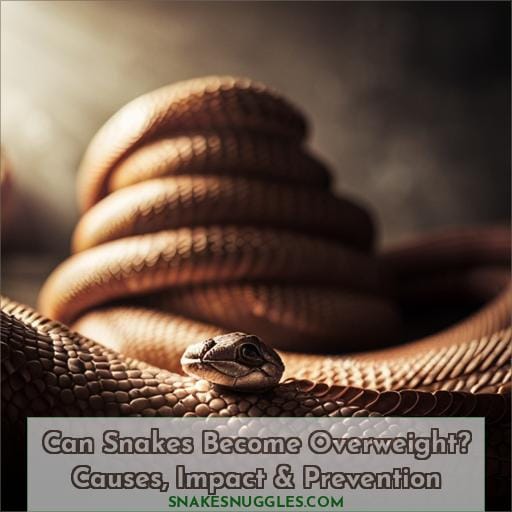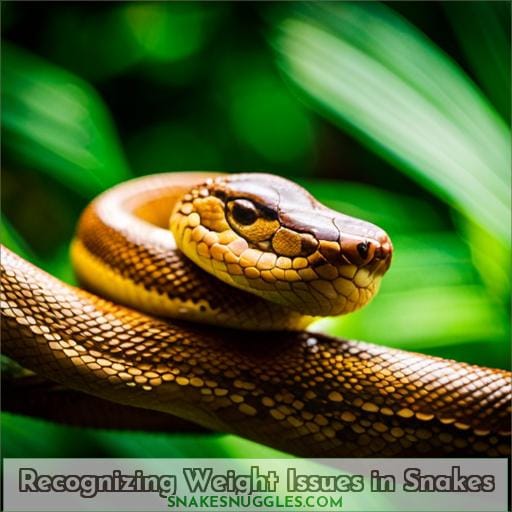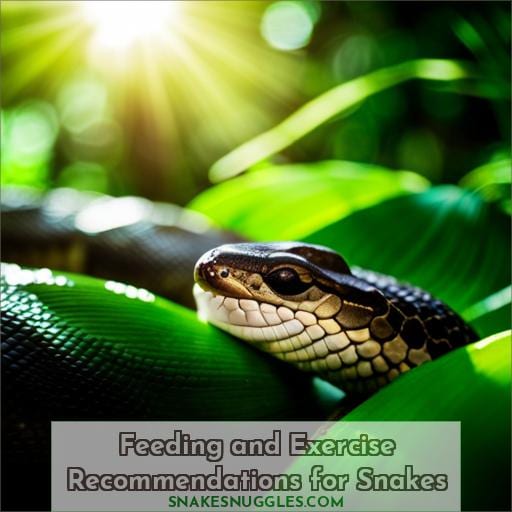This site is supported by our readers. We may earn a commission, at no cost to you, if you purchase through links.

While some species of snakes tend to have thicker builds than others due to their genetics, obesity in reptiles should not be overlooked or ignored as this can lead to serious medical issues down the line.
For those who want a pet snake with good health and longevity – understanding the factors contributing towards obesity along with its impact and ways of prevention holds key importance.
So let’s unravel this myth together: Can Snakes Become Overweight?
Table Of Contents
Key Takeaways
- Snakes, like humans, can suffer from obesity, leading to potential health problems.
- Overeating and a sedentary lifestyle are primary contributors to snake obesity.
- Captive environments can induce weight gain in snakes due to reduced exercise opportunities.
- Maintaining a proper diet and exercise routine is crucial for managing snake obesity.
Factors Contributing to Snake Obesity
Snakes, like humans, can experience weight gain from overeating and a sedentary lifestyle. Boas and pythons are prone to obesity due to their naturally sedentary behavior, while other species store energy as fat for slow metabolisms.
Captive snakes, in particular, are more likely to become overweight due to limited energy expenditure combined with an inability of some snakes to recognize when they’re full and increased fat storage during winter months.
Sedentary Species
Boa constrictors and pythons, notorious for their sluggish lifestyles, are particularly prone to developing unhealthy weight conditions. These species have a higher risk of scale spreading due to their sedentary behavior and an inability to recognize fullness.
Captive environments can contribute significantly too as they limit energy expenditure.
Proper handling techniques should also be adopted when it comes to snake husbandry. Quick cleaning processes help reduce stress on the snake while maintaining a healthy environment overall.
Fat Storage
You may not realize it, but many snakes store energy as fat in order to support their slow metabolisms. This is achieved by storing subcutaneous and visceral body fat, which helps them regulate metabolism rates and energy expenditure while reducing stress.
Healthy levels of snake body fat can be maintained through proper diet, exercise opportunities within safe zones of their enclosure, and an appropriately sized habitat that allows for growth patterns according to the species’ size and weight.
It’s important to monitor dietary intake as well as offer the right types of food for optimal health outcomes when caring for your pet snake!
Captive Environment
Don’t be fooled, even in captivity, snakes can gain too much weight if they don’t exercise enough. Captive care is essential for the snake’s health and well-being. This includes providing adequate space with stress reduction techniques like proper cleaning and deodorizing.
Exercise opportunities should also be available, such as climbing structures or roaming zones outside of the enclosure.
Additionally, feeding schedules must align with a species’ natural diet needs and body condition goals to ensure healthy weight maintenance over time. It’s important to understand that different snake species have varying growth rates.
Therefore, incorporating these specific needs into their captive environment will help keep them happy and healthy while preventing obesity risks associated with sedentary lifestyles or inability to recognize fullness when eating in captivity.
Inability to Recognize Fullness
Some snakes may be prone to overeating due to their inability to recognize when they’re full. Recognizing triggers, such as stress or environmental factors, can help in weight monitoring and adjusting diets accordingly.
Stress management is important for snake care, with a proper exercise routine being essential for overall health.
Feeding experiments can also be used to determine the ideal snake weight range and identify signs of both overweight and underweight conditions early on. With the right diet adjustment and exercise plan in place, owners can ensure that their pet snakes maintain healthy body weights without risking obesity-related health issues.
Winter Months
During winter, snakes tend to store up extra fat as energy reserves due to their slow metabolisms. This can make them appear thicker than usual and potentially cause overweight conditions in sedentary species like boas and pythons.
To avoid this, a varied diet is important for snakes with regular exercise opportunities in safe roaming zones. Stress reduction via proper enclosure care also helps keep snake weight issues at bay; if unsure, speak with a qualified snake vet about consultation options for your pet’s unique needs regarding the medical concept of obesity.
Impact and Symptoms of Snake Obesity
Overeating and lack of exercise can lead to serious health issues in snakes, such as obesity. Symptoms include an increased girth, softness, and inactivity. This can also cause organ problems like clogged arteries that affect the overall health of a snake.
Health Issues
You may notice health issues associated with snake obesity, such as clogged arteries and organ problems. This can be caused by inadequate dietary needs being met, too much stress in their environment, or not enough activity levels.
Other factors impacting a snake’s weight-related issues include enclosure size and not having a medical concept of obesity like humans do due to their distinct physiology.
To prevent this from happening, correct dietary needs must be provided along with sufficient exercise opportunities for optimal longevity of the snake. Proper cleaning practices should also be implemented, which reduces stress on the animal.
Symptoms
Identifying an overweight snake can be easy – look for increased girth, softness, and a lack of activity. To prevent obesity in snakes: 1) adjust feeding schedules; 2) provide climbing structures and opportunities for physical exercise; 3) understand the species’ growth rates and specific needs.
Snake obesity is associated with clogged arteries, organ problems, and reduced lifespan if not addressed through weight indicators like spreading scales or elevated back. Corn snake experiments show overfeeding as the primary cause of increased weight, emphasizing the importance of proper enclosure size and cleaning practices to reduce stress on the animal while encouraging activity essential for long-term health benefits.
Organ Problems
Recognizing organ problems due to overweight conditions can be tricky, so arm yourself with anachronistic knowledge. Clogged arteries, snake kidney, and liver issues are common health risks snakes face when they become obese.
Stress reduction is key in maintaining proper weight for these reptiles. Providing safe roaming zones outside the enclosure helps eliminate stress while promoting exercise. Weight issues should be monitored closely as increased girth and softness are indicators of obesity.
Considering the species’ growth rate and size of its enclosure is also important for recognizing problems early on. Ensuring a comfortable environment through proper cleaning practices will help reduce stress levels, which in turn promotes better snake health overall.
Prevention and Management of Snake Obesity
When it comes to preventing and managing snake obesity, there are several important factors to consider. Encouraging activity through providing climbing structures and promoting exercise is essential for snakes in captivity, while adjusting feeding schedules according to species variations can help combat the issue.
Additionally, understanding the medical concept of obesity in each particular species is also key for maintaining a healthy weight.
Encouraging Activity
By providing climbing structures and opportunities for physical activity, you can help your snake stay fit and healthy. Incorporating exercise routines into their daily lives will prevent obesity-related issues from arising.
Adjusting the enclosure size to fit their growth is essential in allowing them enough space to move around freely. A varied diet consisting of different foods such as insects or fruits can also be beneficial in ensuring they maintain a healthy weight while reducing stress levels due to changes in routine.
Furthermore, understanding the medical concept of obesity (which differs greatly from humans) is key when it comes to recognizing potential signs of overweight snakes so that proper steps may be taken at an early stage before any further health concerns arise.
Taking all these preventive measures will ensure a happy and contented snake with no worries about weight gain!
Feeding and Exercise
Monitoring feeding habits with techniques like portion control and smart feeding can help prevent overindulgence in snakes. Managing your snake’s diet and encouraging regular exercise can help keep them healthy and fit. Create a feeding pattern that works for you, as overfeeding is the primary cause of obesity in snakes.
Exercise regimes are also important to burn calories. Provide climbing structures or let them roam around an appropriately sized enclosure.
To reduce stress levels, make sure to clean their environment regularly with proper tools like a cat litter scooper and deodorize with vinegar if needed!
Diet variation is key too. Experiment with different foods to maintain a balanced weight state while still meeting your pet’s nutritional needs.
By making these small changes in their lifestyle, you’ll be able to ensure that they stay happy and healthy without any long-term health issues associated with overweight conditions!
Species Variation
Understanding the unique needs of each species is key to maintaining a healthy weight for your scaly friends. Factors that can affect a snake’s ability to maintain their weight include habitat changes, metabolic rates, food types, temperature control, and genetic predisposition.
When providing an appropriate environment for snakes, it’s important to consider these factors as well as the size of their enclosure and how often they are fed.
Finally, understanding the specific needs of each species will help you create conditions where they have every opportunity to keep proper body weight without sacrificing comfort or happiness.
Medical Concept of Obesity
Recognizing there is no medical concept of obesity for snakes as there is for humans, it’s vital to know their specific needs in order to keep them healthy and fit. Morphological changes resulting from an excessive amount of fat can occur over time.
As such, monitoring the snake’s nutritional requirements and weight control is crucial. To maintain ideal body composition, focus on developing weight loss strategies that are tailored towards the particular species involved while controlling overall caloric intake.
Adjusting diets accordingly or providing exercise opportunities may also help with promoting a healthier lifestyle in snakes prone to becoming overweight due to captivity or metabolic traits like scale spreading.
Weight management requires knowledge about a given species’ habits and behaviors; ultimately helping ensure they stay healthy by avoiding unnecessary fat accumulation associated with long-term health risks concerns both physical and mental well-being.
Recognizing Weight Issues in Snakes
Identifying weight issues in your snake can be a tricky task, as there are multiple indicators to look out for.
It is important to understand the species’ natural characteristics and breeding habits when assessing health-related weight problems. Diet quality should also be taken into account. Providing an appropriate amount of food will help ensure that the snake does not become overweight due to overeating.
Temperature control is essential for maintaining muscle tone in snakes. If they stay too cold or too hot, they may struggle with proper digestion and metabolism regulation, which could lead to obesity over time.
Finally, it’s important to keep track of your snake’s weight regularly. This way, you can identify any changes early on and take action accordingly before it becomes a more serious issue down the line.
Naturally Thicker Snakes Vs. Overweight Snakes
Snakes, like other creatures, can vary in body size and shape due to genetic differences. However, it is important to recognize the difference between naturally thicker snakes and overweight ones. Comparisons can be drawn between snake obesity and its human counterpart, while underweight snakes may also experience health issues due to their lower-than-normal weight.
Genetic Variability
Knowing the genetic variability of different snake species is key to distinguishing naturally thicker snakes from those that are overweight. Genetic diversity among species means appropriate diets and exercise routines must be tailored to their captive needs.
Environmental factors can also influence growth rate and size. To maintain a healthy weight, it’s essential for owners to research each snake’s individual dietary requirements and provide ample opportunities for physical activity.
Keeping an eye on your pet’s girth will help you recognize any discrepancies between its normal shape and potential signs of obesity, such as softness or inactivity.
Comparisons and Underweight Snakes
Comparing the health of overweight snakes to humans can help you understand their vulnerability to obesity-related issues. Underfeeding and genetic predispositions affect body composition, while climate change and seasonal diets may contribute too.
While some snake species are naturally thicker due to genetics, others may become overweight from overeating or inactivity. Overweight snakes can experience clogged arteries, organ problems, softness, and an increased girth.
On the other hand, underfed snakes will have a lean shape with protruding ribs or a visible spine.
It’s important for owners to recognize weight issues by understanding the natural characteristics of each species. Additionally, providing safe roaming zones outside their enclosures for physical activity is crucial.
Feeding and Exercise Recommendations for Snakes
Maintaining a healthy weight for snakes requires careful attention to their diet and exercise. To ensure proper snake health, it is important to provide them with varied meals and opportunities for physical activity within an appropriately sized enclosure that follows good cleaning practices.
Varied Diet
Experimenting with different foods and adjusting diets can help keep your snake’s weight in check. A varied diet, while accounting for enclosure size and stress reduction, is essential to prevent unnecessary weight issues.
Diet adjustments should be based on the species’ medical concept of obesity as well as its growth rate and size needs. Feeding schedules must also take into account their natural characteristics so that you can recognize any potential weight issues early on.
Adjustments to the diet should always combine exercise opportunities like providing climbing structures or safe roaming zones outside of their enclosure for physical activity that helps them burn off calories while promoting overall well-being; this will ensure a happy and healthy snake!
Exercise Importance
You need to give your snake plenty of exercise so they can stay healthy and fit. Regular activity helps reduce stress, maintain environmental needs, as well as keep up with a healthy diet.
To ensure proper caloric intake for growth and development, increase the activity level in their enclosure through climbing structures or roaming areas outside its habitat.
Exercise allows snakes to burn off excess fat created by overeating, which can lead to serious health problems if left untreated.
Enclosure and Environment
Setting up an appropriate and stress-free enclosure for your snake is essential in promoting exercise and health. Ensure the area provides safe roaming zones with enough space to move around. Adjust the size of their environment according to a species’ growth rate to help keep them healthy.
Proper cleaning practices, such as using a cat litter scooper, can help reduce stress on your pet. Deodorizing with vinegar keeps the enclosure free from bacteria or parasites that could harm them.
A case study involving corn snakes shows how overfeeding leads to increased weight.
Proper Enclosure Care
Take the time to create a clean, stress-free environment for your snake and you’ll be rewarded with a healthy, happy reptile. Ensure that their enclosure is the appropriate size relative to their growth and provide safe roaming areas for exercise.
Proper cleaning of tools like litter scoops can help reduce stress on them as well.
Feeding habits should also be adjusted according to individual needs while monitoring temperature control in order to maintain optimal health conditions.
Medical care may also be necessary in cases where weight issues arise due to overfeeding or underfeeding; however, some species are naturally thicker than others so it’s important not to confuse genetics with obesity problems when managing feeding habits and overall diet plans.
Frequently Asked Questions (FAQs)
How can I tell if my snake is overweight?
Overweight snakes can face serious health problems. Approximately 70% of captive snakes are overweight due to overfeeding and sedentary lifestyles. To determine if your snake is overweight, look for symptoms such as increased girth, softness, or inactivity.
Achieving a healthy weight requires adjusting the diet and promoting exercise, which are crucial steps for ensuring long-term wellbeing.
What kind of diet should I provide my snake?
Provide your snake with a varied diet of proteins, fruits, and vegetables to ensure it maintains its ideal weight.
Are there any potential risks of overfeeding my snake?
Yes, overfeeding your snake can be risky. Too much food can lead to health issues such as obesity and organ problems. It’s important to adjust feeding schedules and promote exercise for a healthy lifestyle.
What kind of exercise is best for a snake?
Exercise is beneficial for a snake’s health and well-being! Try activities like climbing structures, providing roaming areas outside the enclosure, or adjusting feeding schedules.
Are there any supplements I should give my snake?
Supplementing your snake’s diet is an option, but should be discussed with a vet.
Conclusion
Overall, it’s clear that snakes can indeed become overweight if not cared for properly. With a combination of a varied diet, exercise, and appropriate enclosure size, snake owners can help prevent and manage obesity in their pets.
Sedentary species, captive environments, and the inability to recognize fullness are some of the main factors that can contribute to snake obesity.
Symptoms of snake obesity include increased girth, softness, and inactivity. Additionally, organ problems can arise as a result of overweight conditions. Therefore, it’s important to be aware of a snake’s natural characteristics and to be mindful when providing food and exercise to ensure they remain healthy and happy.












